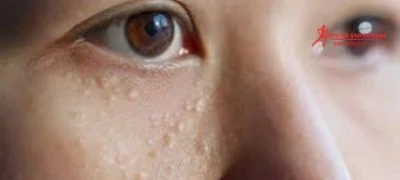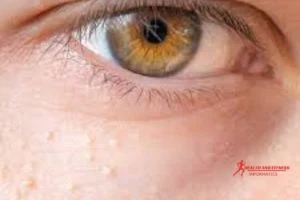Milia (Bumps) under the eyes: causes, diagnosis, treatment, prevention:
Small
bumps under your eyes also called milia. Milia are developed due to the
accumulation of keratin under the skin. They often happen around or under your
eyes. Health experts don’t know the exact reason behind its formation, but the
use of steroid creams or trauma may cause milia.
Overview
Milia are the small yellowish or white bumps under or around
your eyes, developed as keratine (a protein) trapped under the skin.
Milia often occur in children and newborns, but adults may be affected by it. Most people puzzle Milia with skin tags or acne spots. They may go away on their own, but sometimes removal (either by medical treatment or by home remedies) is needed to get clear skin and prevent damaging vision.
This article provides comprehensive
information about Milia, including their causes, diagnosis, possible
treatments, and home remedies.
What is Milia?
Milia
are tiny, yellowish, or white bumps that typically appear on the face or other
parts of your skin. They are caused by the accumulation of keratin, a protein,
underneath the skin's surface. Milia can develop in people of all ages,
including newborns, and are usually not harmful.
How common are bumps under the eyes?
Milia
or bumps under your eyes are very common and usually not dangerous. Some
individuals named them “milk spots”, and mistake them for pimples or acne
blemishes.
A study
showed Milia is more common in older women1.
Can Milia develop in other areas of my body?
Bumps
under the eyes or Milia can appear in other areas of your body, but adults may
be around the forehead, cheeks, eyes, and genitals2
How does milia develop?
Milia are a tiny collection of rapt Keratin. Keratin is a protein, which provides strength to your nails, hair, and skin cells. When these skin cells die off and
drop within pores, the keratin may collect and become trapped in the pore,
developing a little milium, or cyst.
Editor's picks
What is Chilblains or perniosis?
Giant Papillary conjunctivitis
Can milia damage my eyes?
When
Milia develop very close to your eye, your healthcare provider may refer you
to an opthalmologist to treat the abrasions. But if they find them at a safe
distance from the eye, they may feel comfortable performing treatment to remove
them.
Causes
What causes bumps under my eyes?
Bumps under the
eyes could be due to a variety of reasons including:
1. Milia
One common
cause of bumps under the eyes is Milia, which are small, white, or yellowish
bumps caused by trapped keratin beneath the skin's surface.
2. Syringomas
Another
possibility is that they could be syringomas, which are harmless sweat duct
tumors.
3. Certain cosmetic procedures or trauma
Some
individuals get bumps under the eyes, which may be from undergoing cosmetic
procedures or trauma. However, there is no obvious reason why some individuals
develop them while others don’t.
4. Use of steroids
In rare cases,
an individual may get bumps under the eyes after using a topical medication,
such as corticosteroids3.
Edito's pick
What is Mottled skin or livedo reticularis?
Diagnosis
How Milia is diagnosed?
If you go to
your healthcare provider, they may refer you to a dermatologist or
opthalmologist. Physical examination is typically enough for your doctor to be
able to diagnose Milia.
If you have a
lot of bumps, your healthcare provider may also need to check for underlying
conditions that could be causing multiple Milia.
A condition
that your healthcare provider will reveal during the diagnosis of Milia
includes inherited genetic skin disorders, such as genodermatosis. They may
also investigate conditions that don’t lead to Milia but can give a similar
appearance, including4:
Idiopathic
calcinosis cutis
- Sebaceous hyperplasia
- Flat warts
- Comedonal acne
Treatment
How milia is treated?
Some cases of milia
clear up without any treatment within a few months. Most people who had milia
on their faces as infants no longer have any.
However, this
is not always the case, and there is no set standard for treatment. Although
the bumps are not harmful, many people have cosmetic concerns about milia under
the eyes and on the face.
Never press a
milium as they would a pimple. This will irritate your skin and may damage your
sensitive skin in the area.
Your healthcare
provider may suggest you following
treatment options including:
Over-the-counter treatment:
Chemical peels
To remove the
top layer of the skin chemical peels are applied. They can
improve the appearance of wrinkles, uneven skin tone, acne scars, fine lines,
and other skin issues.
Remember,
over-the-counter exfoliative chemicals are not likely to remove milia under the
eyes.
A chemical peel
has these common ingredients such as:
- Glycolic acid
- Lactic acid
- Salicylic acid
Remember, your
under-eye area is very sensitive, so it’s crucial to take extra care while
using chemical peel. Don’t use chemical peel until your dermatologist will
recommend it.
Professional options
Here are some
professional treatment options your dermatologist may perform to remove milia
in their clinic, including:
1. Laser ablation
Laser
ablation is a treatment that removes the top layer of your skin and heats the
deeper layer, which helps stimulate the growth of collagen. This makes the skin
under your eyes firmer and smoother as the top layer of skin heals and grows
back.
Collagen is a
protein that makes your skin feel smoother and firmer.
During laser
ablation, your dermatologist will use a small laser to target the milium
directly, opening the pore.
2. Extraction
Milium extraction is a common procedure where your
dermatologists will use a small scalpel or needle to take off a part of the
skin covering the cyst. By opening the pore in this manner, they can gently
remove the keratin. After this, you will need to take preventive measures to
stop the milia from returning.
3. Cryotherapy
Cryotherapy is a procedure in which your
dermatologist will use very cold temperatures to remove or freeze the bumps
under your eyes. This treatment will be done using liquid nitrogen or maybe
other freezing agents.
In some cases, cryotherapy can help get rid of milia. But, because the skin under the eyes is delicate, cryotherapy might not be the best choice for treating milia in that area. It could hurt and leave scars or change the skin color.
Prevention
How can I prevent milia?
Not all cases
of Milia are preventable, as some people may be more liable for them than
others.
However, you
can follow these general preventive measures to prevent Milia including:
- Using a prescription or topical retinoids
- Avoid trauma to the skin
- Maintaining a good skincare routine such as gentle cleansing cleansing
Home remedies
Most treatments you can do at home for milia
involve gently removing dead skin or using special chemicals. But, it's
important to talk to a doctor before trying these methods, especially near your
eyes. A doctor might also be able to remove the milia in their office.
Why do I get Milia under my eyes?
You get Milia
under your eyes due to taking certain medications (such as corticosteroids) or
skin trauma. The second reason for having Mila is an inherited genetic skin
disorder5.
How do I get rid of Milia under my eyes naturally?
Unreliable
evidence suggests the following may help a person to get rid of milia under
their eyes naturally:
It can be
helpful to use a manuka honey face mask when dealing with Milia, as research
has found anti-inflammatory properties in honey. Additionally, it's important
to avoid picking or poking milia bumps, as this can slow down the healing
process. Instead, try gently exfoliating and steaming the skin to help bring
trapped keratin to the surface. Milia occurs due to an excess of keratin, so
this method may be effective in helping to resolve the issue.
How can I get rid of Milia myself?
You can try gentle
exfoliation at home. Be careful while scrubbing or exfoliation as it can hurt
your under eye skin.
By
exfoliation, your Milia will resolve within one month to even one year depending
on your skin condition.
Conclusion
Milia are small cysts that form under the skin, caused by the buildup of keratin. They are often found on the face, and around or under the eyes. It is important to keep in mind that milia are not pimples, and squeezing them can lead to further damage to the skin, inflammation, and scarring. Clearing the built-up keratin from the pores is necessary for the milia to disappear.
If you notice deeper milia or milia around sensitive areas such as your eyes, it is best to seek professional treatment. Your dermatologist can help diagnose and suggest treatment options if you experience recurring milia in the same area.







Post a Comment